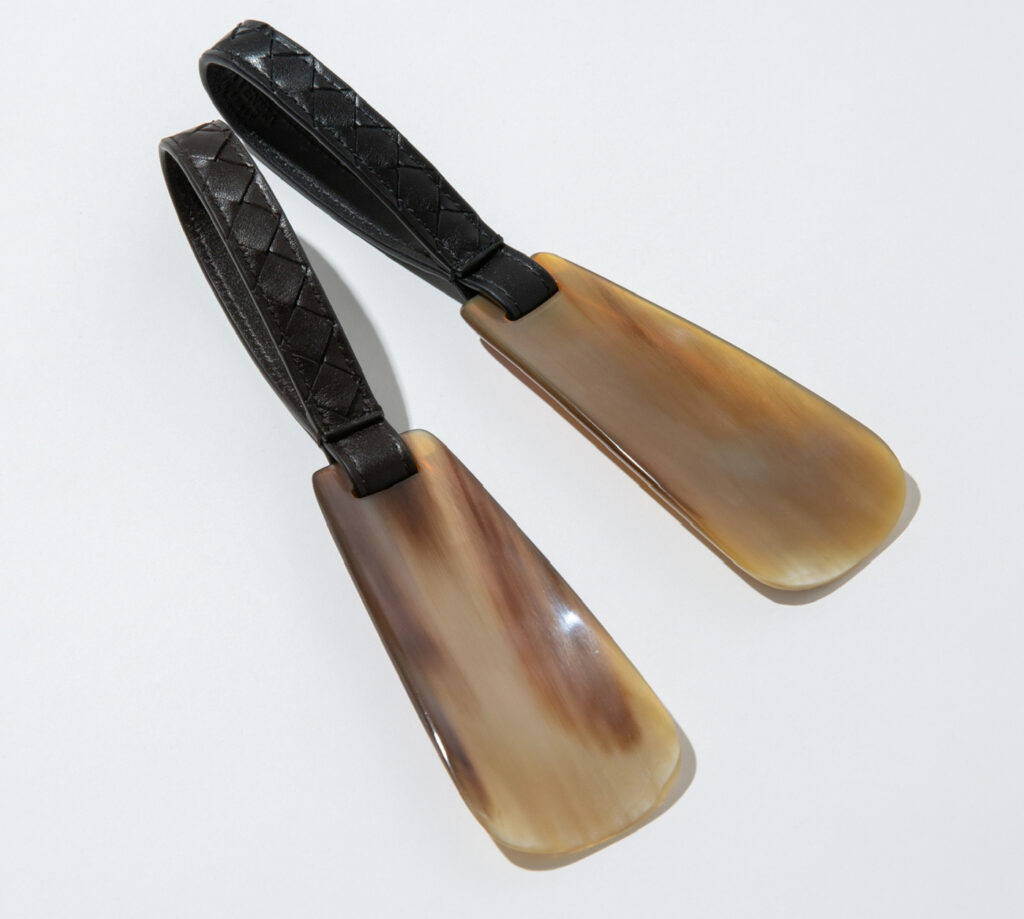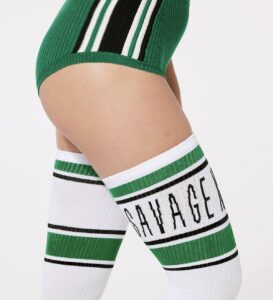In an age dominated by overstatement—where maximalism roars from runways and logos fight for dominance on every accessory—Bottega Veneta continues to whisper. And in that whisper, it resounds louder than most. While the Italian house is best known for its woven leather handbags and its directional tailoring, it also excels in the realm of the minute. The Bottega Veneta Shoe Horn is not simply an accessory—it is a meditative object, one that stands as a distillation of the brand’s larger philosophy: that true luxury lies in intention, restraint, and the reverence of use.
Crafted in Italy, the Bottega Veneta shoe horn is a slim, sculptural item that could be easily mistaken for a gallery object—smooth, curved, and devoid of unnecessary embellishment. In its form, we find the spirit of quiet flow: something functional rendered with uncommon grace. While a shoe horn may seem a curious focal point in a brand known for commanding entire silhouettes, Bottega’s rendition insists on the radical notion that utility and beauty are not mutually exclusive. In fact, their coexistence is precisely where elegance lives.
A Philosophy of Form: Minimalism Meets Heritage Craft
The house of Bottega Veneta, founded in Vicenza in 1966, built its reputation on artisanal discretion. Its famed intrecciato weave—the leather technique that eschews loud branding in favor of craft—was not just a stylistic gesture. It was an identity. The Bottega of today, under the creative direction of Matthieu Blazy, maintains this core tenet while pushing toward sculptural futurism. Even the most utilitarian items in the brand’s collection are imbued with a sense of ceremonial presence.
The shoe horn is a perfect example of this. Designed with a sleek curve and finished in polished horn or smooth lacquered wood, it turns the act of slipping on a shoe into something nearly sacred. It’s not merely about ease—it’s about ritual. About honoring the transition between bare foot and shoe, between rest and movement.
Blazy’s Bottega, inheriting Daniel Lee’s legacy and the precepts before him, has demonstrated an almost architectural interest in silhouette and silhouette-supporting tools. Where a lesser brand might outsource or downplay something as trivial as a shoe horn, Bottega Veneta reclaims it. It becomes an object worthy of consideration, of design, and of permanence.
Material Matters: Elevating the Everyday
What sets the Bottega shoe horn apart isn’t just its form, but its material integrity. It is typically crafted in materials like polished ox horn, brushed steel, or lacquered wood—each chosen not just for durability, but for tactility. These materials invite touch, responding to the warmth of the hand and aging over time. Like Bottega’s leather goods, the shoe horn is meant to patina, to remember its user. It’s a rejection of disposability. A whisper of continuity.
This is, in many ways, the ethos of Bottega writ small. While others chase novelty, Bottega refines necessity. The brand doesn’t need to remind the world of its status with monograms or gimmicks. Instead, it crafts an object like the shoe horn so well, so meticulously, that it becomes undeniable. It turns an afterthought into a symbol of sensibility.
There is also an implicit environmental and ethical consideration here. In a world plagued by fast fashion and trend cycles, investing in something as durable—and seemingly minor—as a shoe horn encourages slower consumption. Fewer broken plastic tools, fewer discarded cheap materials. Instead, an heirloom-quality object that could, conceivably, outlast the shoes it serves.
A Personal Ritual: The Shoe Horn as Extension of Self
There is something deeply intimate about the Bottega shoe horn. It requires touch. It meets the heel. It knows your stride. Unlike a handbag or outerwear, it is not something meant for public display, but for private rhythm. It sits, perhaps, on a hall bench or beside a well-worn pair of Chelsea boots. It’s part of the unobserved choreography of daily life—like brushing one’s hair or tying a tie. And yet, it defines how you begin the day.
In this way, the shoe horn becomes more than an object—it becomes part of the self. A tool that shapes how you move through the world, quietly insisting on care, on deliberation. It reflects a mode of dressing that values preparation over spontaneity, that sees refinement not as performance but as practice.
For the collector or connoisseur, the shoe horn holds symbolic weight. It completes the footwear story. It nods to cobblers, to dressing rooms, to the art of the shoe itself. Bottega, ever aware of fashion’s histories, leans into this resonance. In doing so, it offers the modern luxury consumer something rare: not just a product, but a gesture of respect toward the items we wear and the bodies we clothe.
A New Kind of Status: The Anti-Logo Statement
In fashion’s current dialectic between quiet luxury and statement maximalism, the Bottega shoe horn plants its flag firmly—and silently—on the side of the former. It is the antithesis of logo-heavy status symbols. No one on the street will know you use a Bottega shoe horn. But you will. That’s the point.
This signals a deeper shift in how we view luxury. No longer simply about display, true luxury now often resides in invisibility. It’s in the feel of a well-made lining, the weight of a real horn accessory, the smooth insertion of foot into shoe without tugging or damaging. It’s about process, not posturing.
And in that shift, brands like Bottega lead the charge—not with bombast, but with rigor. By dedicating design resources to something as humble as a shoe horn, they demonstrate an almost monastic belief in quality. That’s more radical than it seems.
The Small Monument
To call Bottega Veneta’s shoe horn a “product” feels somehow insufficient. It is, rather, a monument—small, yes, but significant. It marks a moment in fashion’s ongoing meditation on what it means to live with objects, to choose permanence over trend, to find dignity in even the most utilitarian gestures.
It does not shout. It does not sparkle. It simply is, and in being so, it reminds us that refinement begins in the smallest places. At the edge of the heel. At the touch of horn to skin. In that quiet moment between standing still and stepping forward.
In other words: this is not just a shoe horn. It is Bottega Veneta, distilled.
No comments yet.








